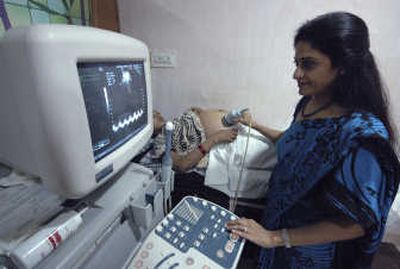Commercial surrogacy taking off in India

ANAND, India – Every night in this western Indian city, 15 pregnant women prepare for sleep in the spacious house they share.
A team of maids, cooks and doctors looks after the women, whose pregnancies would be unusual anywhere else. The young mothers of Anand, a place famous for its milk, are pregnant with the children of infertile couples from around the world.
The small clinic at Kaival Hospital matches infertile couples with local women, cares for the women during pregnancy and delivery, and counsels them afterward. Anand’s surrogate mothers, pioneers in the growing field of outsourced pregnancies, have given birth to roughly 40 babies.
More than 50 women in this city are pregnant with the children of couples from the United States, Taiwan, Britain and beyond. The women earn more than many would make in 15 years. But the program raises questions that touch on morals and modern science, exploitation and globalization, and the desire to have a family.
Dr. Nayna Patel, the woman behind Anand’s baby boom, defends her work as meaningful for everyone involved.
“There is this one woman who desperately needs a baby and cannot have her own child without the help of a surrogate. And at the other end there is this woman who badly wants to help her (own) family,” Patel said. “If this female wants to help the other one … why not allow that?”
Experts say commercial surrogacy – or what has been called “wombs for rent” – is growing in India. While no reliable numbers track such pregnancies nationwide, doctors work with surrogates in virtually every major city. The women are impregnated in-vitro with the egg and sperm of couples unable to conceive on their own.
Commercial surrogacy has been legal in India since 2002, as it is in many other countries, including the United States. But India is the leader in making it a viable industry rather than a rare fertility treatment. Experts say it could take off for the same reasons outsourcing in other industries has been successful: a wide labor pool working for relatively low rates.
Critics say the couples are exploiting poor women in India – a country with an alarmingly high maternal death rate – by hiring them at a cut-rate cost.
“It raises the factor of baby farms in developing countries,” said Dr. John Lantos of the Center for Practical Bioethics in Kansas City, Mo. “It comes down to questions of voluntariness and risk.”
Patel’s surrogates are aware of the risks because they’ve watched others go through them. Many of the mothers know one another; some are related. Three sisters have all borne strangers’ children, and their sister-in-law is pregnant with a second surrogate baby. Nearly half the babies have been born to foreign couples, while the rest have gone to Indians.
Ritu Sodhi, a furniture importer from Los Angeles who was born in India, spent $200,000 trying to get pregnant through in-vitro fertilization, and was considering spending another $80,000 to hire a surrogate mother in the United States.
“We were so desperate,” she said. “It was emotionally and financially exhausting.”
Then, on the Internet, Sodhi found Patel’s clinic.
After spending about $20,000 – more than many couples because it took the surrogate mother several cycles to conceive – Sodhi and her husband are now back home with their 4-month-old baby, Neel. They plan to return to Anand for a second child.